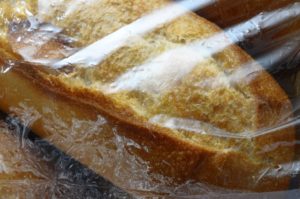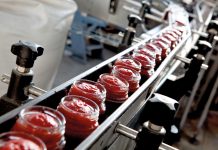 Thanks to the growing use of biodegradable materials for the protection of foods, proteins and starches obtained from legumes and seeds have acquired particular interest, as they can be used to produce competitive films, replacing synthetic materials.
Thanks to the growing use of biodegradable materials for the protection of foods, proteins and starches obtained from legumes and seeds have acquired particular interest, as they can be used to produce competitive films, replacing synthetic materials.
Films based on natural biopolymers offer several advantages, including the fact that they can be produced by casting: the liquid material is poured into a mold, where it solidifies to create the desired object. This simple method has the advantage that a variety of ingredients, such as antioxidant or antimicrobial agents, may be easily added to the films in order to extend the shelf-life and prevent the spoilage of food during storage.
Cinnamon and clove essential oils, having a high content of eugenol – a powerful antimicrobial molecule – can be added as bioactive ingredients. Unfortunately, when bioactive ingredients are incorporated in a biopolymeric film, they have a high risk of degradation due to several environmental factors, a.o. Light, oxygen, and pH. However, they can be protected by means of an emulsification-encapsulation process, which leads to the formation within the film of stable droplets called emulsions. An additional advantage of encapsulating a bioactive component in a film is that it can be gradually released where required, while keeping a good stability.
A study conducted in Chile and Mexico by J. Castano et al. (2017, 353) had as objective the development of films with blends of polysaccharide and polysaccharide-protein. The raw materials employed to this purpose were protein, carrageenan and karu starch, the latter already widely used in the food industry as gelling agents, whereas Faba beans (Vicia Faba L.) seeds were used to extract the protein.
To these blends the emulsified essential oils of cinnamon and clove were added in the film as an antifungal agents. The films were prepared according to the methods described in the following, whereby the aim was to obtain the maximum compatibility between proteins and polysaccharides by means of specific conditions of pH and temperature.
1) Proteins were extracted from Vicia Faba bean seeds, that were sun dried, crushed and ground. The seed flour obtained was sieved to obtain particles of less than 0.2 mm; then a solution of sodium sulphite was added as preserving agent; finally the pH was adjusted to 10.5. The solution was held in stirring for 24 hours at 4 °C; then the pH was reduced to assist the precipitation of proteins. After centrifugation the protein isolate was washed twice with distilled water and stored for subsequent freeze drying process and then ultra-frozen at -40°C for 24 hours; the protein obtained was stored until it was used.
2) Karu starch, source of polysaccharides, was isolated by the wet milling method. This method involves grinding of the seeds of starch in a blender with water. The homogenate obtained was filtered through a 60 mesh nylon cloth (equivalent to a particle size of 250 μm). After this, the result of the first grinding was homogenized with the same conditions, and then filtered through a 270 mesh nylon cloth (equivalent to a particle size of 53 μm). The result of the second grinding was left at ambient temperature for 20 hours to decant. The supernatant was discarded and the precipitate was suspended in a solution of sodium hydroxide to solubilize the proteins. The residual precipitate was centrifuged to separate the starch from proteins. The precipitated starch was adjusted at pH 6.0, and then filtered under vacuum conditions and thoroughly washed with distilled water. The samples were dried in an oven at 60 °C and stored until their use.
3) Preparation of polysaccharide-polysaccharide films using Karu starch and carrageenan Karu starch was pre-gelatinized by adding hot water (60 °C) and stirring the solution in a magnetic stir-hot plate. After the carrageenan previously blended with glycerol was added to the pre-gelatinized starch solution. The substances were blended at 70 °C and then poured in glass petri dishes. The films were obtained by drying the blends in a forced convection oven at 35 °C for 24 hours; then they were recovered with a flat metal spatula. Films incorporating emulsions were obtained by adding the (clove or cinnamon) emulsions to the solutions containing starch or carrageenan.
4) Preparation of polysaccharide-protein films using carrageenan and proteins extracted from the seeds of Vicia Faba beans. Firstly, the isolate proteins were dissolved in distilled water, the pH was adjusted at 10, and the whole solution was stirred in a magnetic stir-hot plate at 70 °C. To this solution the carraggeenan was added, which was previously blended with glycerol. Then, the protein / carrageenan solution was kept in stirring at 70 °C and poured in glass petri dishes, where films were obtained as previously described.
5) Preparation of emulsions The aqueous phase was prepared dissolving Arabic gum and maltodextrin in distilled water. The oily phase consisted of essential oils (clove or cinnamon) and mineral oil. Thus, two oil-in-water emulsions were prepared by adding to the aqueous phase each one of the two essential oils, drop-by-drop, while the solution was stirred. During the emulsion preparation, an ice bath was used to maintain the temperature below 30 °C, to delay the coalescence of the system. In sum, this study shows the optimal conditions to obtain polysaccharide-polysaccharide and polysaccharide-protein films with adequate characteristics to be used in the food industry and successfully incorporating cinnamon and clove oil emulsions into the matrices. The films exhibit high thermal stability, whereas their mechanical properties are within the range reported for main conventional plastic materials employed in food packaging. The films containing cinnamon oil emulsions are particularly interesting for their high antifungal performance against Botrytis cinerea and Rhizopus stolonifer.
References Castano et al., Journal of Materials Science 52, 2017, 353



